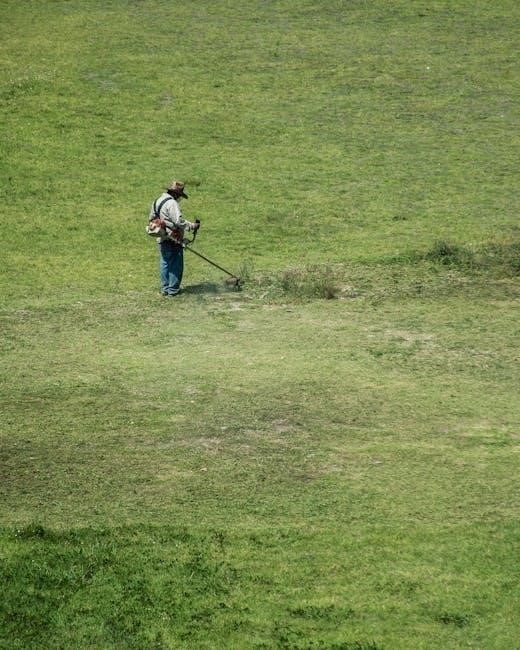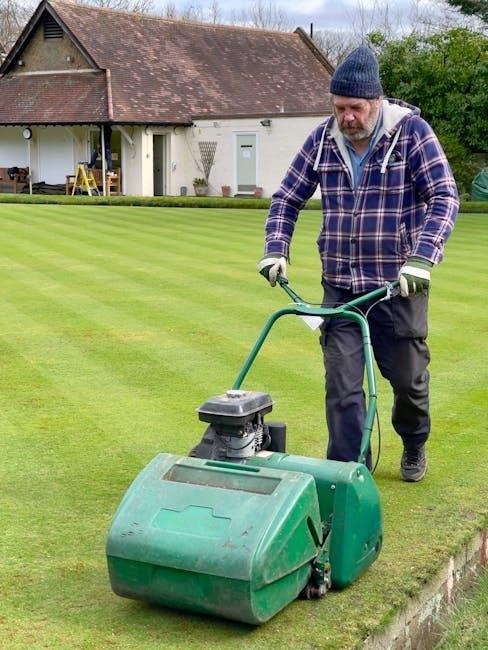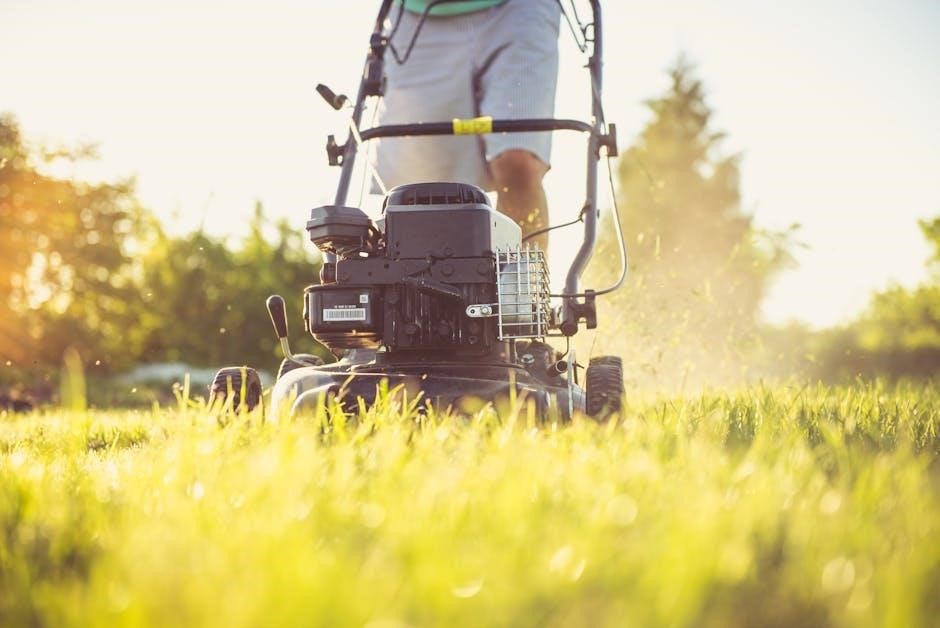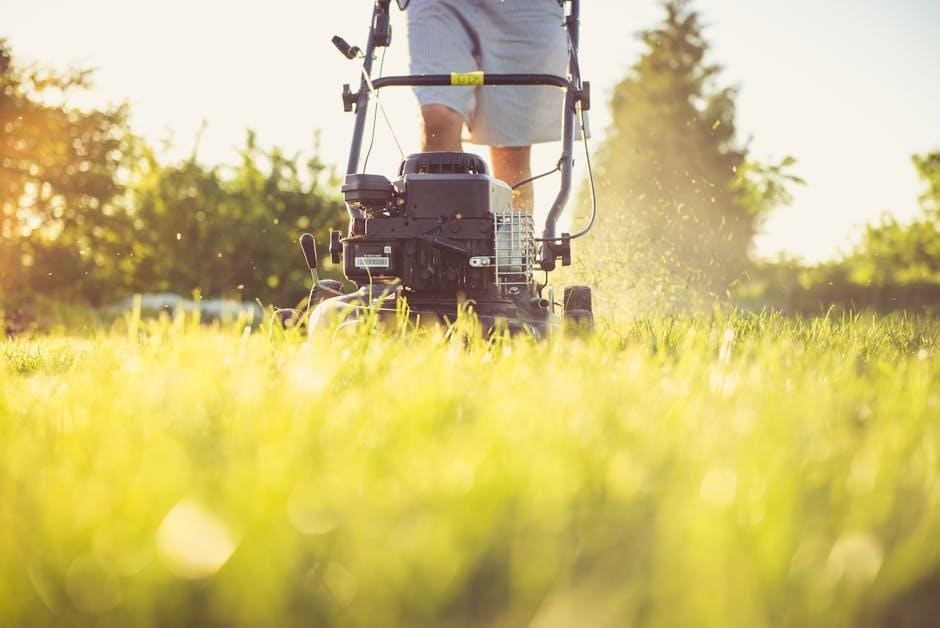The Troy-Bilt push mower is a reliable and durable lawn care tool, offering various models to suit different yard sizes and mowing needs. Known for its robust design and user-friendly features, this mower provides efficient cutting performance. Whether you’re maintaining a small lawn or tackling larger areas, Troy-Bilt push mowers deliver consistent results. This guide will walk you through everything you need to know to operate, maintain, and troubleshoot your Troy-Bilt push mower effectively.
1.1 Overview of Troy-Bilt Push Mower
The Troy-Bilt push mower is a versatile and efficient lawn mowing solution designed for homeowners seeking reliable performance. Available in various models, these mowers feature powerful engines, durable construction, and user-friendly designs. Key features include adjustable mowing heights, mulching capabilities, and easy maneuverability. Many models come with innovative technologies like automatic choke systems and high-capacity cutting decks. The push mower is ideal for small to medium-sized lawns, offering a balance of power and portability. With a focus on ease of use and maintenance, Troy-Bilt push mowers are a popular choice for achieving a well-manicured lawn with minimal effort. They are built to last, ensuring years of dependable service.
1.2 History of Troy-Bilt Brand
Troy-Bilt, a trusted name in outdoor power equipment, has a rich history dating back to 1937. Founded in Troy, New York, the company initially produced horse-drawn rototillers, later transitioning to engine-powered models. Known for innovation, Troy-Bilt introduced the first walk-behind tiller in 1967. Over the years, the brand expanded its product line to include mowers, trimmers, and other lawn care tools. Acquired by MTD Products in 2001, Troy-Bilt continues to be a leader in the industry, offering high-quality equipment designed for both residential and commercial use. The brand remains committed to durability, performance, and customer satisfaction, making it a favorite among homeowners and professionals.

Safety Features and Precautions
Safety is paramount when operating a Troy-Bilt push mower. Always wear protective gear, follow guidelines, and ensure proper equipment function to avoid accidents and ensure safe mowing.
2.1 Essential Safety Equipment
To ensure safe operation of your Troy-Bilt push mower, always wear appropriate safety gear. This includes sturdy gloves to improve grip and protect hands, safety goggles to prevent eye injury from debris, and durable, closed-toe shoes or boots. Hearing protection, such as earplugs, is recommended to safeguard against engine noise. Additionally, wear long pants and avoid loose clothing or jewelry that could get caught in moving parts. Always check that the mower is on a level surface before starting and ensure the area is clear of obstacles or bystanders. Proper safety equipment minimizes risks and ensures a secure mowing experience.

2.2 Operating Safety Guidelines

Always start the mower on a level surface and ensure the area is clear of obstacles, children, and pets. Never mow in reverse unless absolutely necessary, and always look down and behind before reversing. Keep loose clothing and long hair tied back to avoid entanglement. Avoid mowing wet grass, as it can be slippery and reduce visibility. When mowing slopes, go uphill to maintain control and prevent the mower from tipping. Never leave the mower unattended while it is running. Wear safety goggles during operation to protect against debris. Avoid operating the mower when fatigued or under the influence of medications or alcohol. Properly dispose of grass clippings and waste materials to maintain eco-friendly practices.
Assembly and Setup Instructions
Begin by carefully unpacking and inventorying all components. Follow the step-by-step assembly guide to attach handles, wheels, and mower deck. Ensure all bolts are securely tightened.
3.1 Unpacking and Inventory
When you receive your Troy-Bilt push mower, carefully unpack all components from the box. Inspect for any damage or missing parts. Essential items include the mower deck, handlebars, wheels, and hardware. Refer to the provided parts list to ensure everything is accounted for. Take note of smaller components like bolts, nuts, and washers, as these are crucial for assembly. If any items are missing or damaged, contact Troy-Bilt customer support immediately. Properly organizing the parts will streamline the assembly process. Always follow the manufacturer’s guidelines for handling and storing components to avoid loss or damage.

3.2 Step-by-Step Assembly Process
Begin by attaching the handlebars to the mower deck using the provided hardware. Ensure all bolts are tightened securely to maintain stability. Next, install the wheels by aligning the axles with the mower deck and fastening them with the included nuts. Use a wrench or screwdriver to tighten these properly. Afterward, connect the throttle and brake cables to the handlebar controls, ensuring they are securely fastened. Finally, attach the grass bag or mulching kit if included. Double-check that all parts are properly aligned and tightened before proceeding. Refer to the manual for specific torque settings and cable adjustments to ensure optimal performance and safety.
Operating Instructions
Start the mower by priming the engine and pulling the recoil handle. Adjust the mowing height as needed for even cutting. Safely navigate various terrains, ensuring efficiency and safety by following manual guidelines.
4.1 Starting the Mower
To start the Troy-Bilt push mower, ensure the area is clear and the mower is on a level surface. Prime the engine by pressing the primer bulb 2-3 times until it feels firm. Pull the choke lever to the “start” position. Grip the recoil handle firmly and pull it in one swift motion until the engine starts; Once the engine is running, move the choke lever to the “run” position. Allow the mower to warm up for a few seconds before engaging the blade. Always refer to the manual for specific starting procedures, as slight variations may exist depending on the model.
4.2 Adjusting Mowing Height
Adjusting the mowing height on your Troy-Bilt push mower ensures a clean, even cut for your lawn. Locate the height adjustment lever, typically found on the mower deck or handlebar. Pull the lever to lower the blade or push it to raise it. Choose from multiple preset positions to match your lawn’s needs. For most grass types, a height of 2.5 to 3 inches is recommended. After adjusting, ensure the lever is securely locked to maintain the selected height. Always adjust the blade height before mowing and avoid cutting more than one-third of the grass blade length to promote healthy growth. Proper height adjustment prevents scalping and maintains lawn health.
4.3 Handling Different Terrain Types
Your Troy-Bilt push mower is designed to handle various terrain types, ensuring efficient mowing on flat, sloped, or uneven ground. For flat surfaces, maintain a steady pace and keep the mower level. When mowing slopes, always go across the slope to maintain control and prevent tipping. For uneven terrain, raise the mowing deck slightly to avoid damaging the blade or scalp the lawn. Use a slower, more deliberate pace to navigate obstacles like trees or gardens. Adjust the mower’s wheels or handle height as needed for comfort and stability. Regularly inspect the mower deck for debris buildup after mowing rough areas. By adapting your technique to the terrain, you ensure a smooth and even cut every time.

Maintenance and Care Tips
Regular maintenance ensures optimal performance and extends the lifespan of your Troy-Bilt push mower. Clean the mower deck, lubricate moving parts, and sharpen blades periodically for consistent results.
5.1 Regular Cleaning Procedures
Regular cleaning is essential to maintain your Troy-Bilt push mower’s performance and longevity. Start by turning off the engine and allowing it to cool. Remove any debris, grass clippings, or dirt from the mower deck using a brush or garden hose. Check and clean the air filter to ensure proper airflow. Inspect the blade for damage or wear and clean it thoroughly. Sharpen the blade annually to maintain cutting efficiency. Additionally, clean the chute and discharge area to prevent clogs. Lubricate moving parts as recommended to reduce friction and wear. Regular cleaning prevents rust, improves functionality, and ensures your mower operates at peak performance throughout the mowing season.
5.2 Lubrication and Oil Change
Regular lubrication and oil changes are crucial for extending the life of your Troy-Bilt push mower. Check the oil level before each use and top it off as needed using the recommended oil type. Change the oil annually or after every 50 hours of use. Drain the old oil into a container, then refill with fresh oil. Lubricate pivot points, such as wheel axles and height adjusters, to ensure smooth operation. Refer to your manual for specific oil viscosity recommendations. Proper lubrication prevents overheating, reduces wear on moving parts, and keeps the engine running efficiently. Dispose of used oil responsibly to protect the environment.
5.3 Blade Maintenance and Sharpening
Regular blade maintenance is essential for optimal cutting performance. Inspect the blade before each use for damage or wear. Sharpen the blade every 20-25 hours of use or when cutting efficiency decreases. To sharpen, turn off the mower, disconnect the spark plug, and remove the blade. Use a grinder or file to maintain the original angle, ensuring the blade remains balanced. Wear gloves and safety glasses during this process. After sharpening, reinstall the blade securely. Replace the blade if it is cracked or excessively worn; Proper blade care prevents uneven cutting and extends the mower’s lifespan. Always dispose of metal shavings responsibly.

Troubleshooting Common Issues
Regular maintenance and inspections help prevent issues. Common problems include engine start failures, uneven cutting, and wheel misalignment. Always check fuel levels, spark plugs, and blade condition. Address issues promptly to ensure optimal performance and extend mower lifespan.
6.1 Engine Not Starting
If the engine fails to start, check the fuel level and ensure the tank is not empty. Verify that the choke is properly adjusted and the throttle is in the correct position. Inspect the spark plug for cleanliness and proper connection. A dirty or worn-out spark plug may need to be cleaned or replaced. Additionally, check the air filter for blockages or damage and clean or replace it as needed. Ensure the ignition switch is functioning correctly. If issues persist, consult the manual or contact Troy-Bilt customer support for further assistance. Regular maintenance can help prevent such problems and ensure smooth operation.
6.2 Uneven Cutting Problems
Uneven cutting can occur due to a dull or unbalanced blade, improper mowing height, or debris in the mower deck. To address this, sharpen or replace the blade and ensure it is balanced. Clean the mower deck thoroughly to remove any blockages. Adjust the mowing height evenly on both sides to maintain consistency. Additionally, check the tire pressure and ensure the mower is moving at a steady pace. If the issue persists, inspect the blade for damage or wear and replace it if necessary. Regular maintenance, such as sharpening the blade and cleaning the deck, can help prevent uneven cutting and ensure a smooth, professional-looking lawn finish.
6.3 Wheel and Alignment Issues
Wheel and alignment problems can hinder the mower’s performance and cause uneven cutting. Common issues include wobbly wheels, misaligned axles, or uneven tire wear. To address this, inspect the wheels for looseness and tighten any bolts. Check the axle alignment by ensuring the mower moves straight when pushed. If misaligned, adjust according to the manufacturer’s instructions. Uneven tire wear may indicate improper inflation or uneven terrain use. Rotate or replace tires as needed. Regularly cleaning debris from wheels and lubricating axles can prevent such issues. Always refer to the manual for specific adjustment procedures to maintain optimal performance and extend the mower’s lifespan.
Storage and Winterization
Proper storage and winterization ensure your Troy-Bilt push mower remains in great condition. Clean the mower thoroughly, drain fuel, and store in a dry, protected area during winter.
7.1 Proper Storage Techniques
Properly storing your Troy-Bilt push mower is essential to maintain its functionality and longevity. Begin by cleaning the mower deck and blade to remove any grass clippings or debris, which can cause rust or corrosion over time. Ensure the mower is dry to prevent moisture buildup. Store the mower in a cool, dry place such as a garage or shed, away from direct sunlight and extreme temperatures. If storing for an extended period, consider covering it with a breathable cover to protect it from dust. Proper storage techniques help preserve the mower’s performance and ensure it’s ready for the next mowing season.
7.2 Winter Preparation Steps
Winter preparation for your Troy-Bilt push mower involves several key steps to ensure it remains in optimal condition. Drain the fuel tank completely or add a fuel stabilizer to prevent degradation during storage. Change the oil to remove contaminants and protect the engine. Sharpen the blade to maintain cutting efficiency for the next season. Clean the mower deck thoroughly to prevent rust or corrosion. Store the mower in a dry, protected area, such as a garage or shed, and cover it with a breathable cover to shield it from dust and moisture. Proper winter preparation ensures your mower is ready to perform when spring arrives.
Warranty and Customer Support
Troy-Bilt push mowers are backed by a comprehensive warranty program, ensuring coverage for parts and labor against defects. The warranty period varies by model and components. Customers can register their product online to activate warranty benefits. For assistance, Troy-Bilt offers dedicated customer support through phone, email, or live chat. The official website provides detailed warranty terms, FAQs, and repair center locations. Additional support resources include user manuals, troubleshooting guides, and video tutorials to help resolve common issues. With a focus on customer satisfaction, Troy-Bilt ensures reliable service and support to keep your mower performing at its best.
8.1 Understanding the Warranty
Troy-Bilt push mowers are backed by a comprehensive warranty program designed to protect your investment. The warranty typically covers defects in materials and workmanship for a specified period, varying by model and components. For most mowers, the warranty includes coverage for the engine, mower deck, and other critical parts. To activate the warranty, users must register their product on the Troy-Bilt website or complete and mail the registration card included with the purchase. The warranty does not cover damage caused by normal wear and tear, misuse, or lack of maintenance. Always review the warranty terms in your owner’s manual or visit the Troy-Bilt website for detailed information.
8.2 Contacting Customer Service
Troy-Bilt offers multiple avenues for customer support to ensure your questions and concerns are addressed promptly. You can reach their customer service team via phone, email, or live chat through their official website. For phone inquiries, call the toll-free number listed on their website during business hours, typically Monday through Friday, 8 AM to 5 PM EST. When contacting, have your mower’s model and serial number ready for faster assistance. Additionally, the Troy-Bilt website features a comprehensive support section with FAQs, manuals, and troubleshooting guides. For warranty-related inquiries or technical support, visit the “Support” page on their website or use the “Contact Us” form to submit your request.

Environmental Considerations
Troy-Bilt push mowers emphasize eco-friendly practices, such as efficient fuel use and proper waste disposal. Regular maintenance reduces emissions and prolongs equipment life, promoting sustainability.
9.1 Eco-Friendly Mowing Practices
Adopting eco-friendly mowing practices with your Troy-Bilt push mower can significantly reduce environmental impact. Always maintain the mower deck at the recommended height to promote healthy grass growth, which naturally reduces weed growth and the need for herbicides. Additionally, using a mulching feature, if available, helps recycle grass clippings into nutrient-rich fertilizer. Proper disposal of waste materials, such as oil and filters, is crucial to prevent environmental contamination. Regular maintenance ensures the engine runs efficiently, minimizing fuel consumption and emissions. By following these practices, you contribute to a more sustainable lawn care routine that benefits both your yard and the environment.
9.2 Disposal of Waste Materials
Proper disposal of waste materials from your Troy-Bilt push mower is essential for environmental protection. Always drain oil and fuel responsibly, taking them to designated recycling centers. Old filters, batteries, and metal parts should be recycled or disposed of according to local regulations. Grass clippings and organic waste can be composted or bagged for municipal pickup. Avoid pouring hazardous materials like oil or fuel into drains or soil, as this can contaminate water and ecosystems. Check with local authorities for specific guidelines on disposing of small engine components and other waste. Proper disposal ensures a cleaner environment and reduces pollution risks.

Accessories and Upgrades
Troy-Bilt push mowers can be enhanced with various accessories, such as mulching kits, grass catchers, and replacement blades, to improve functionality. Upgrades like high-performance wheels and adjustable handles are also available to customize your mowing experience, ensuring optimal performance and comfort.
10.1 AvailableAttachments
10.1 Available Attachments
Troy-Bilt push mowers support a variety of attachments to enhance functionality. Key options include mulching kits, which convert grass clippings into fine mulch, and grass catchers for tidy lawn maintenance. Additionally, striping kits are available to create professional-looking lawn patterns. Other attachments like baggers and leaf collection systems help manage debris efficiently. These accessories are designed to be easy to install and use, allowing users to adapt their mower to different tasks and seasons. By utilizing these attachments, homeowners can achieve a well-manicured lawn with minimal effort, making yard work more efficient and enjoyable. Explore the range to find the perfect fit for your needs.

10.2 Upgrading Your Mower
Upgrading your Troy-Bilt push mower can enhance its performance and versatility. Consider upgrading the engine for more power or installing a high-capacity cutting deck for larger lawns. Sharper blades or mulching capabilities can improve cut quality. Adding larger wheels or adjustable handles can increase maneuverability and comfort. Ensure all upgrades are compatible with your mower’s model and follow the manufacturer’s guidelines. Regularly check Troy-Bilt’s official website for approved accessories and instructions. Upgrading responsibly can extend your mower’s lifespan and improve efficiency. Always prioritize safety and manufacturer recommendations when making modifications.
